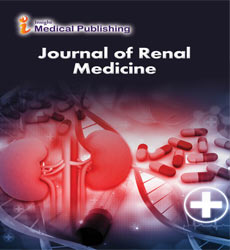Renal Replacement Therapy Restoring Balance in Kidney Dysfunction
Eva Alberto*
Department of Surgery, Medical University of Vienna, Vienna, Austria
- *Corresponding Author:
- Eva Alberto
Department of Surgery,
Medical University of Vienna, Vienna,
Austria,
E-mail: alberto@foxmail.com
Received date: February 23, 2024, Manuscript No. IPJRM-24-18915; Editor assigned date: February 26, 2024, PreQC No. IPJRM-24-18915 (PQ); Reviewed date: March 11, 2024, QC No. IPJRM-24-18915; Revised date: March 18, 2024, Manuscript No. IPJRM-24-18915 (R); Published date: March 25, 2024, DOI: 10.36648/ipjrm.7.2.15
Citation: Alberto E (2024) Renal Replacement Therapy Restoring Balance in Kidney Dysfunction. Jour Ren Med Vol.7 No.2: 15.
Description
Renal Replacement Therapy (RRT) is a cornerstone of modern medicine, providing life-saving interventions for individuals with acute or chronic kidney failure. Renal Replacement Therapy plays a vital role in the management of kidney failure, offering a range of interventions to restore metabolic equilibrium, alleviate symptoms, and improve overall quality of life. From hemodialysis and peritoneal dialysis to continuous renal replacement therapy and kidney transplantation, each modality has its indications, mechanisms, benefits, and challenges. As we continue to advance our understanding of renal pathophysiology and therapeutic strategies, the future holds promise for more personalized, innovative approaches to RRT, ultimately enhancing outcomes and transforming the lives of patients with kidney disease.
Renal replacement therapy
The kidneys play a vital role in maintaining homeostasis within the body by filtering waste products, regulating electrolyte balance, and controlling fluid volume. However, when renal function declines due to Acute Kidney Injury (AKI) or Chronic Kidney Disease (CKD), these essential functions are compromised, leading to a cascade of metabolic derangements and clinical complications. Renal Replacement Therapy (RRT) serves as a lifeline for individuals with End-Stage Renal Disease (ESRD) or those experiencing severe kidney dysfunction. By replicating the filtration and excretory functions of the kidneys, RRT aims to restore metabolic equilibrium, alleviate symptoms, and improve overall quality of life. Hemodialysis is the most commonly utilized form of RRT, particularly in patients with ESRD. This extracorporeal therapy involves the circulation of blood outside the body through a hemodialyzer, or artificial kidney, which removes waste products and excess fluid before returning the purified blood to the patient's circulation. Hemodialysis sessions typically last three to four hours and are performed several times per week in a dialysis center or at home with proper training and equipment. Peritoneal dialysis offers an alternative to hemodialysis, utilizing the peritoneum's natural membrane as a dialyzing surface. In this modality, a sterile dialysis solution is instilled into the peritoneal cavity via a catheter, allowing waste products and excess fluids to diffuse across the peritoneal membrane. The spent dialysate is then drained, and fresh solution is introduced in a cyclic fashion throughout the day or during nocturnal exchanges, providing continuous renal support. Continuous Renal Replacement Therapy (CRRT) is primarily employed in critically ill patients with hemodynamic instability or multiorgan failure requiring hemodynamic and metabolic stabilization. Unlike conventional intermittent hemodialysis, CRRT provides continuous removal of solutes and fluids over an extended period, typically 24 hours, using a slow continuous flow system. This gentler approach minimizes hemodynamic fluctuations and is better tolerated in hemodynamically fragile patients, such as those in the Intensive Care Unit (ICU). Kidney transplantation remains the gold standard treatment for eligible candidates with ESRD, offering the potential for long-term renal function restoration and improved quality of life. In this surgical procedure, a healthy donor kidney is transplanted into the recipient's body, replacing the failed native kidneys. While transplantation provides the closest approximation to natural renal function, challenges such as organ shortages, immunologic barriers, and the need for lifelong immunosuppression limit its availability and success rates.
Mechanisms of renal replacement therapy
The underlying principles of RRT revolve around the processes of diffusion, convection, and ultrafiltration, which facilitate the removal of waste products, toxins, and excess fluid from the bloodstream. Diffusion involves the passive movement of solutes across a semipermeable membrane down a concentration gradient. In hemodialysis and peritoneal dialysis, solutes such as urea, creatinine, and electrolytes diffuse from the blood into the dialysate solution, driven by differences in their concentrations on either side of the membrane. Convection relies on the bulk movement of solutes and fluids across a membrane under the influence of hydrostatic pressure. In CRRT, a combination of diffusion and convection is utilized to remove larger molecular weight substances, such as cytokines and inflammatory mediators, through the continuous flow of dialysate or replacement fluid across the hemofilter. Ultrafiltration refers to the removal of excess fluid from the bloodstream by applying a transmembrane pressure gradient. This process is essential for managing fluid overload and achieving euvolemia in patients with volume-dependent conditions such as congestive heart failure or fluid-refractory shock.
Open Access Journals
- Aquaculture & Veterinary Science
- Chemistry & Chemical Sciences
- Clinical Sciences
- Engineering
- General Science
- Genetics & Molecular Biology
- Health Care & Nursing
- Immunology & Microbiology
- Materials Science
- Mathematics & Physics
- Medical Sciences
- Neurology & Psychiatry
- Oncology & Cancer Science
- Pharmaceutical Sciences
